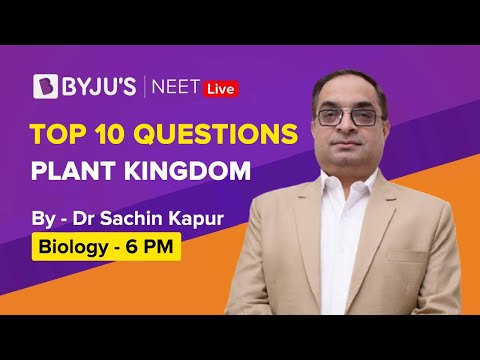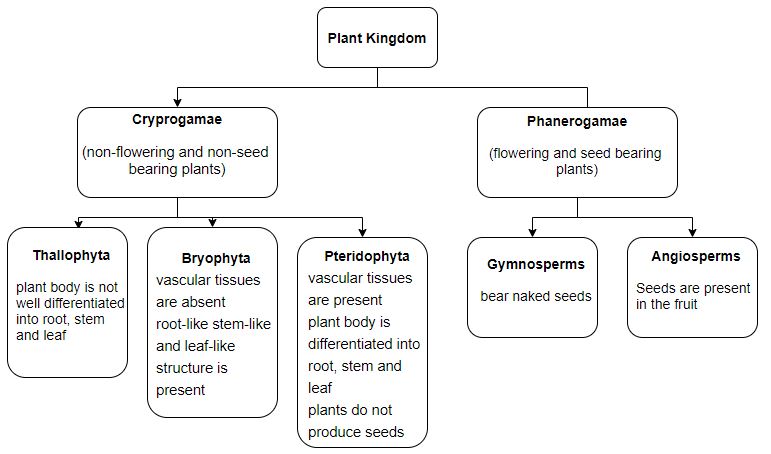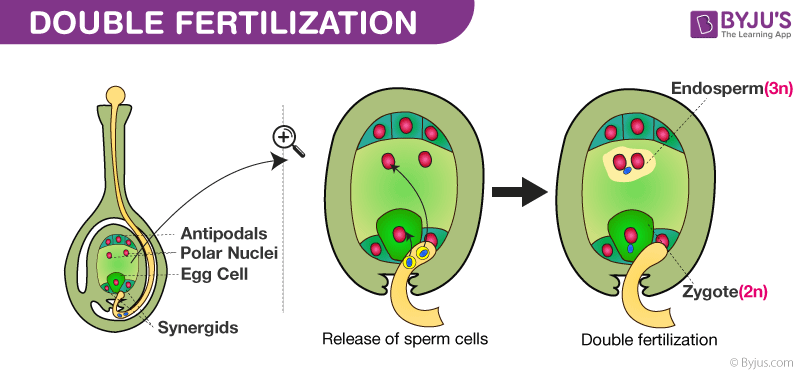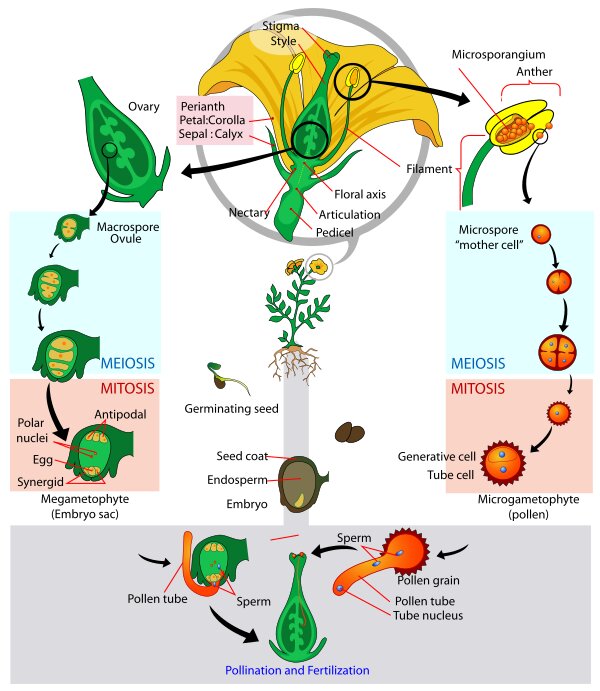Find below the important notes for the chapter, Plant Kingdom as per NEET Biology syllabus. This is helpful for aspirants of NEET and other exams during the last-minute revision. Important notes for NEET Biology- Plant Kingdom covers all the important topics and concepts useful for the exam. Check BYJU’S for the full set of important notes and study material for NEET Biology and solve the NEET Biology MCQs to check your understanding of the subject.
Download Complete Chapter Notes of Plant Kingdom
Download Now
Table of Content
ClassificationAlgaeBryophytesPteridophytesGymnospermsAngiosperms
| Name of the NEET sub-section | Topic | Notes helpful for |
| Biology | Plant Kingdom | NEET exams |
Recommended Video:

Plant Kingdom – Important Points, Summary, Revision, Highlights
Plant Kingdom
Whittaker (1969) classified living organisms under five kingdoms; Monera, Protista, Fungi, Plantae and Animalia based on various features such as complexity of cellular and body structure, mode of nutrition, etc.
There have been various attempts to classify organisms. Aristotle classified plants 2000 years ago as herb, shrub and trees. The various systems of classification are:
- Artificial system- based on only a few morphological characteristics, e.g. Linnaeus classified plants based on the structure and number of stamens present.
- Natural system- based on morphological as well as anatomical characters such as cellular ultrastructure, embryology, phytochemistry, etc. Examples include Bentham and Hooker classification, they divided plants based on the presence and absence of flowers and seeds into Phanerogamia and Cryptogamia respectively.
- Phylogenetic system- based on evolutionary and genetic relationship of plants, e.g. Whittaker, Engler and Prantl, Eichler, etc.
Various modern taxonomic advancements include:
- Numerical taxonomy- a statistical method using computers, gives equal importance to various different characters
- Cytotaxonomy- based on cytological information such as chromosome structure, number, etc.
- Chemotaxonomy- based on chemical constituents
Classification of Plant Kingdom

Algae
- The plant body is thallus, which may be filamentous, Colonial, unbranched or branched and massive
- Some of the special characteristics of the plant body of various algae are:>> Spirogyra (water-silk), Ulothrix- filamentous>> Volvox- colonial>> Unicellular- Chlamydomonas, Acetabularia (largest unicellular algae), also known as the umbrella plant>> Ectocarpus- filamentous branched and epiphytes (grow on other plants)>> Kelps- giant brown algae, profusely branched and massive, may reach up to the height of 100 metres>> Brown algae- holdfast attaches the plant to a substratum, the stalk is known as stipe, frond- leaf-like and carries out photosynthetic
- They have mostly aquatic habitat, that can be marine or freshwater
- Algae are autotrophic and have chlorophyll. Different shapes of chloroplast present are:>> Girdle shaped in Ulothrix>> Ribbon-shaped in Spirogyra>> Cup-shaped in Volvox and Chlamydomonas>> Reticulate in Oedogonium>> Disc-shaped in Caulerpa>> Star-shaped in Zygnema
- Reproduction is by a vegetative, sexual and asexual method
- Vegetative reproduction is by fragmentation
- Asexual reproduction is by various spores formation, e.g. zoospores (motile), Aplanospores, Akinetes (non-motile), etc.
- Sexual reproduction is by fusion of gametes. Sexual reproduction is of three types:
Isogamous: male and female gametes are similar in size, e.g. Ulothrix (gametes are motile or flagellated), Spirogyra (non-motile gametes)
Anisogamous: gametes are dissimilar in size, e.g. Eudorina, Chlamydomonas
Oogamous: female gamete is large and non-motile and male gamete is small and motile, e.g. Volvox, Fucus
- Some of the special reproductive structures and processes present in different algae are:>> Sexual reproduction by conjugation in Spirogyra>> Coceptacles of Sargassum, which is a flask-shaped cavity bearing male and female sex organs, antheridia and oogonia respectively>> In Chara sex organs are multicellular and jacketed known as globule (male antheridium) and nucule (female archegonium)
- The life cycle is mostly haplontic, Fucus has a diplontic life cycle, Ectocarpus, Kelps and Polysiphonia have haplo-diplontic life cycle
- Phycology – the scientific study of algae
- Three main classes of algae are Chlorophyceae (green algae), Phaeophyceae (brown algae), Rhodophyceae (red algae)
| Attributes | Algae | ||
| Class | Chlorophyceae | Phaeophyceae | Rhodophyceae |
| Common name | Green Algae | Brown Algae | Red Algae |
| Habitat | Mostly freshwater | Mostly marine | Mostly marine |
| Type of Chlorophyll | Chlorophyll a, b | Chlorophyll a, c | Chlorophyll a, d |
| Other pigments | β-carotene, xanthophylls | Carotenoids, β-carotene, xanthophylls, fucoxanthin | r-phycoerythrin, phycocyanin, β-carotene |
| Stored Food | Starch | Mannitol, laminarin | Floridean starch |
| Cell wall | Cellulose | Cellulose, algin | Cellulose, phosphate esters and pectin |
| Vegetative reproduction | Fragmentation and spore formation | Fragmentation | Fragmentation |
| Asexual reproduction | Flagellated zoospores | Biflagellated zoospores (pear-shaped) having unequal laterally attached flagella | Non-motile spores |
| Sexual reproduction | Isogamous, anisogamous or oogamous | Isogamous, anisogamous or oogamous
Gametes fuse in water or in the oogonium Gametes are pyriform, biflagellated |
Oogamous
Non-motile gametes |
| Examples | Volvox, Ulothrix, Spirogyra, Chlamydomonas, | Fucus, Sargassum, Ectocarpus, Laminaria, Dictyota | Polysiphonia, Gracilaria, Porphyra, Gelidium |
Economic Importance of Algae:
- Algae contribute to half of the total carbon dioxide fixation on the Earth. They increase the oxygen content of their habitat
- They are important primary producers in an ecosystem
- Algae are used as fodder and also in pisciculture
- Algae have medicinal properties and also used to prepare antibiotics, e.g. Chlorella, Ascophyllum, Polysyphonia, etc.
- Alginates like sodium laminarin sulphate and fucoidan are used as a blood anticoagulants
- Many algae are used as food, e.g. Laminaria, Sargassum, Porphyra, Ulva (Sea lettuce), etc.
- Chlorella (unicellular alga) has a rich protein content and frequently used by space travellers as a food supplement (single-cell protein – SCP)
- Hydrocolloids are commercially produced from certain brown and red algae, e.g. algin produced by brown algae and carageen is produced by red algae
- Agar (China grass), obtained from red algae such as Gracilaria and Gelidium, is widely used in laboratories as a growing medium for the tissue culture of microorganism and to prepare various desserts, jellies and icecreams
- Agar is a mixture of agarose (a polysaccharide) and agaropectin present in the cell wall of certain red algae
- Algae are also used in sewage treatment processes to increase the alkalinity and reduce bacteria
Bryophytes
- Bryophytes are non-vascular plants (lack xylem and phloem), plant body is not differentiated into root stem and leaves
- They are found in moist, shady and damp areas
- Bryophyta is categorised into three main classes: Hepaticopsida (liverworts), Anthocerotopsida (hornworts) and Bryopsida (mosses)
- Bryophytes are called “amphibians of plants” because they are terrestrial plants but need water to complete their life cycle
- The plant body is thallus like and prostrate or erect
- The main plant body is the gametophyte, i.e. haploid
- They lack true roots and attached to the substratum by rhizoids, stem-like and leaf-like structures are present
- Vegetative reproduction is by fragmentation, budding, tubers, gemmae, etc.
- Sexual reproduction is by the fusion of male and female gametes (antherozoids and egg or oospore) in the sex organs, which are multicellular and jacketed
- Antheridium produces biflagellated antherozoids
- Archegonium is flask-shaped and produces a single egg
- The Zygote does not undergo meiosis immediately and a short-lived multicellular diploid sporophyte develops. Some of the cells undergo meiosis and produce haploid spores, which develop into a photosynthetic haploid gametophyte
- The life cycle of bryophytes is haplo-diplontic. The gametophyte (haploid) is the main plant body, which is photosynthetic and independent. The diploid sporophyte is short-lived and partially or totally dependent and grows on the gametophyte
| Attributes | Bryophytes | ||
| Class | Hepaticopsida | Bryopsida | Anthocerotopsida |
| Common name | Liverworts | Mosses | Hornworts |
| Gametophyte | -The gametophyte is thalloid or foliose
-Thalloid is dorsiventral and dichotomously branched -Leaves without midrib -Rhizoids are unicellular branched and septate |
-The gametophyte is foliose
-gametophyte develops in two stages 1st stage is protonema, which is creeping, green and develops from spore 2nd stage is the leafy stage, which is upright, bears leaves, bears sex organs and develops as a lateral bud from secondary protonema -leaves have midrib -rhizoids are multicellular and branched |
-The gametophyte is thalloid
-Thalloid is dorsiventral without internal differentiation
|
| Chloroplasts | Many chloroplasts without pyrenoids | Chloroplast is present | Each cell has one chloroplast with a pyrenoid |
| Sporophyte | -Differentiated into the foot, seta and capsule
-Columella is absent, elaters are present -Sporogenous tissues develop from endothecium |
-Differentiated into foot, seta and capsule
-Capsule has sterile columella and peristome teeth, elaters are absent -Sporogenous tissues develop from endothecium |
-Differentiated into foot, meristematic zone and capsule
-Columella and pseudoelaters are present in the capsule -Sporogenous tissues develop from amphithecium |
| Asexual reproduction | -By fragmentation or by formation of gemmae
– Gemmae are green, multicellular and produced in gemma cup |
-By fragmentation and budding in the secondary protonema | -By fragmentation of thallus and by tubers |
| Sexual reproduction | -Male and female sex organs are developed either on the same or different thalli on the dorsal side
-Spores are produced within a capsule after meiosis |
-Sexual organs are produced at the apical region of leafy shoots
-Spores are produced within a capsule after meiosis |
-Waterborne sperms travel to the archegonium
-Sporophyte splits lengthwise to release spores
|
| Examples | Riccia, Marchantia, Sphaerocarpos | Funaria, Polytrichum, Sphagnum | Anthoceros, Megaceros, Notothylas |
Economic Importance of Bryophytes:
- Bryophytes are of great ecological importance as they are the first organisms, that colonise on rocks and makes it suitable for the growth of higher plants by decomposing it
- Mosses form a dense mat on the soil, holds it together and prevent soil erosion by rainwater
- Mosses play an important role in bog succession
- Bryophytes are used for medicinal purposes, e.g. Sphagnum is used in the surgical dressing, Marchantia, Sphagnum and Polytrichum species has also medicinal benefits to cure liver, kidney and skin diseases
- Antibiotics are also extracted from bryophytes
- Mosses provide food for many herbivores
- Peat produced from a moss, Sphagnum is widely used as fuel
- Used as a packaging material due to their water holding capacity
Pteridophytes
- Pteridophytes have a vascular system and the main plant body is the diploid sporophyte
- The plant body is differentiated into root, stem and leaves
- The xylem of pteridophytes lacks vessels and the phloem lacks companion cells and sieve tubes
- They are present in damp, cool and shady places and also found in sandy-soil conditions
- The leaves may be small or large, e.g. Selaginella has small leaves (microphylls), Ferns have large leaves (macrophylls)
- Young leaves show circinate vernation (spirally coiled)
- The spore-producing organ is sporangia, which is present on sporophylls (fertile leaves)
- In Selaginella and Equisetum, sporophylls form a distinct cone known as strobili
- Spores are produced after meiosis and germinate to form the haploid gametophyte also known as a prothallus
- The gametophyte (prothallus) is heart-shaped, multicellular, small and inconspicuous. It is mostly green and performs photosynthesis
- The gametophyte bears antheridia and archegonia, water is required for fertilization
- Young embryos are formed from the development of the zygote within the female gametophyte, which is the precursor to the development of seed in higher plants
- The zygote develops into a well-differentiated sporophyte, which is the dominant phase of pteridophytes
- Mostly pteridophytes are homosporous, i.e. spores germinating into male and female gametophyte are of a similar kind
- Salvinia and Selaginella are heterosporous, i.e. they produce large megaspores and small microspores, that develop into the female and male gametophyte respectively
- The life cycle of pteridophytes is haplo-diplontic, the dominant phase is diploid sporophyte and it alternates with short-lived but independent autotrophic/ saprophytic haploid gametophyte
- Pteridophytes include horsetails and ferns. Main examples are Psilotum, Lycopodium, Selaginella, Equisetum, Pteris, Dryopteris, Adiantum, etc. classified into four main classes; Psilopsida, Lycopsida, Sphenopsida and Pteropsida
| Attributes | Pteridophyta | |||
| Class | Psilopsida | Lycopsida | Sphenopsida | Pteropsida |
| General characteristics | Most primitive | Well-differentiated plant body
Commonly known as Club moss or spike moss |
All are fossils except Equisetum
Commonly known as Horsetail |
Most widely distributed and perennial
Commonly known as Fern |
| Roots | Rhizoids are present | -Adventitious roots develop at the tip of rhizophores
-Rhizophores develop from the stem, which is the intermediate structure between root and stem |
Roots arise from the node of an underground creeping rhizome | Adventitious roots |
| Stem | The stem is photosynthetic and dichotomously branched | The true stem is found, the main stem has erect branches | Nodes and internodes are present on stem | Stem mostly rhizomatous, short and stout |
| Leaves | Leaves often absent | Microphyllous leaves | Scaly leaves present as whorl around a node | Macrophyllous leaves, known as fronds
Young leaves show circinate vernation (spirally coiled) |
| Vascular tissue arrangement | Protostele, i.e. a solid core of xylem is surrounded by phloem, pith is not present | Protostele or siphonostele (central pith region surrounded by vascular tissues) | Siphonostele | Protostele, siphonostele or dictyostele |
| Sporophyte | Homosporous synangium | -Sporangia are borne on the adaxial (upper) surface of sporophylls
-Homosporous or heterosporous -The gametophyte depends on the fungus for food |
-Homosporous
-Strobili bear sporangia |
-Homosporous or heterosporous
-Sporangia are borne on the abaxial (upper) surface of sporophylls -multiflagellate antherozoids |
| Examples | Psilotum and Tmesipteris | Selaginella, Lycopodium | Equisetum (Horsetail) | Pteris, Dryopteris, Adiantum |
Economic Importance of Pteridophytes:
- Pteridophytes are used as soil binders. They bind soil even at the slopes of hills
- Pteridophytes are a good source of food, e.g. Marsilea sporocarps are a good source of starch
- They are used as ornamental plants, leaves are used for the purpose
- Some of the pteridophytes have a medicinal value such as Dryopteris
- Azolla is used as a biofertilizer in the paddy fields due to nitrogen-fixing ability. It has a symbiotic association with a nitrogen-fixing cyanobacteria Anabaena azollae
- Equisetum stems are used for cleaning utensils
Gymnosperms
- Gymnosperms are characterised by the presence of naked seed. Their ovules are exposed and not covered by the ovary wall
- Sequoia (giant redwood) is the tallest, Ginkgo (maidenhair tree) is a living fossil, Zamia is the smallest gymnosperm
- Mostly tap roots are present. In some of the genera like Pinus, symbiotic association with a fungus known as mycorrhiza is found and in others like Cycas, symbiotic association with nitrogen-fixing cyanobacteria is present and the roots are known as coralloid roots
- The stem may be branched, as in Cedrus and Pinus or unbranched, as in Cycas
- Ephedra and Gnetum have xylem vessels
- Leaves may be simple or compound, foliage leaves of Cycas are pinnate and fall off after a few years
- Leaves of gymnosperms have adaptations for extreme environmental conditions. In conifers, leaves are needle-like with sunken stomata and a thick cuticle to reduce the water loss
- Male and female spores are different in gymnosperms, i.e. heterosporous, male and female strobili are found either on the same tree as in Pinus or on different trees as in Cycas. Microspores are produced in microsporangia of male strobili. The male gametophyte is developed from microspores. It is made up of a few cells and known as pollen grains. Megaspores are produced in megasporangia borne on female strobili. The ovule is made up of nucellus and envelope, one of the cells of nucellus is differentiated into megaspore mother cell. Four haploid megaspores are formed after meiotic division in the megaspore mother cell. One of the megaspores develops into a female gametophyte. Two or more archegonia are present within the female gametophyte.
- Both the gametophytes (male and female) are not free-living instead retained within sporangia
- Pollen grains are released and reach the ovules openings by air currents. Pollen tube having male gamete grows inside the ovule and reaches archegonia, where it releases its contents
- After fertilization, an embryo develops from the zygote and the ovule forms seeds
- The life cycle of gymnosperms is diplontic, the diploid sporophyte is the dominant phase
Economic Importance of Gymnosperms:
- Gymnosperms have high medicinal value. It is used to cure various diseases and many drugs are extracted. Ephedrine- extracted from Ephedra and used to cure cough and cold and other respiratory problems. Taxol- extracted from Taxus brevifolia, is an anti-cancer drug. It controls cell division by inhibiting spindle fibre formation. It is used in chemotherapy to treat lung cancer, ovarian cancer, pancreatic cancer, breast cancer, etc. Gum of Cycas is used as an antidote against snake venom and juice of young leaves is used to cure blood vomiting
- Many food products are obtained from gymnosperms. They are a rich source of starch, e.g. sago is obtained from Cycas, eatable seeds of Pinus (pine nuts or chilgoza) and Gnetum
- Gymnosperms are a good source of timber for making furniture, musical instruments, pencil, etc. the wood is known as softwood and it is lightweight, durable and resistant to insects and fungus
- Cedrus deodara has scented wood, the wood of Podocarpus is used to prepare plywood
- Many species are used to extract edible oil and oil for making perfumes and soaps
- Tannins extracted from the bark is used in the leather industry
- Various useful products such as gum, turpentine, resins such as Canada balsam, amber are obtained
- Wood pulp is used to make paper, fibres are used to make rope, fishing net, as a stuffing for pillows
Angiosperms
- Angiosperms are flowering plants and have seeds enclosed in fruits and have well-developed flowers containing reproductive organs
- The size of angiosperms vary from as small as Wolffia with 0.1 cm to tall trees of Eucalyptus, which may grow as long as 100 m
- Angiosperms are divided into two classes; Monocotyledons, Dicotyledons
| Attributes | Angiosperms | |
| Class | Monocotyledons | Dicotyledons |
| No. of cotyledons present in the seed | one | two |
| Root | Fibrous or adventitious | Taproot |
| The vascular system of root | More than 6 xylem bundles, polyarch | 2-4 xylem bundles radially arranged |
| The vascular system of stem | Conjoint, closed | Conjoint, Open and endarch
cambium is present between phloem and xylem Secondary growth is present |
| Leaves | Isobilateral | Dorsiventral |
| Leaf venation | Parallel venation | Reticulate venation |
| Flowers | Trimerous | Tetramerous or pentamerous |
- The flower contains 4 parts; calyx (sepals), corolla (petals), androecium and gynoecium (male and female reproductive parts respectively)
- An ovule bears embryo sac
- The embryo sac: consists of 7 cells and 8 nuclei>> 1 egg cell, haploid>> 2 synergids, haploid>> 3 antipodal cells, haploid>> 1 central cell with 2 polar nuclei, which fuse to form a secondary nucleus, which is diploid
Double fertilization

- Double fertilization is the characteristic of angiosperms
- Two male gametes enter the embryo sac through the pollen tube
- The egg and one male gamete fuse together to form a diploid zygote, the process is known as syngamy
- The second male gamete fuses with the diploid secondary nucleus, the process is known as triple fusion and triploid endosperm is formed
- It is known as double fertilization because two fusions happen, i.e. syngamy and triple fusion
- After fertilization, antipodal cells and synergids degenerate
- Ovaries develop into fruit and ovules develops into a seed
- The life cycle of angiosperms is diplontic, i.e. diploid sporophyte is the dominant, independent and photosynthetic phase of the plant. The gametophyte or haploid stage is represented only by a single or few-celled stage

Also see:
This is very useful✌️✌️✌️👌👌
I’m just impressed💕💕💕
It’s good 👌👌👌🔥👌👌🔥👌👌👌👍👍👍👍
i just loved it
amazing short notes. helped a lot!!! 🙂
Helps a lot , Amazing👍👍👍
Very good and helpful short notes
It’s helpful 👍👍
GREAT WORK VERY USEFUL
Very helpful 👍
very nice thanks for giving us these notes from ncert book
It is very help full